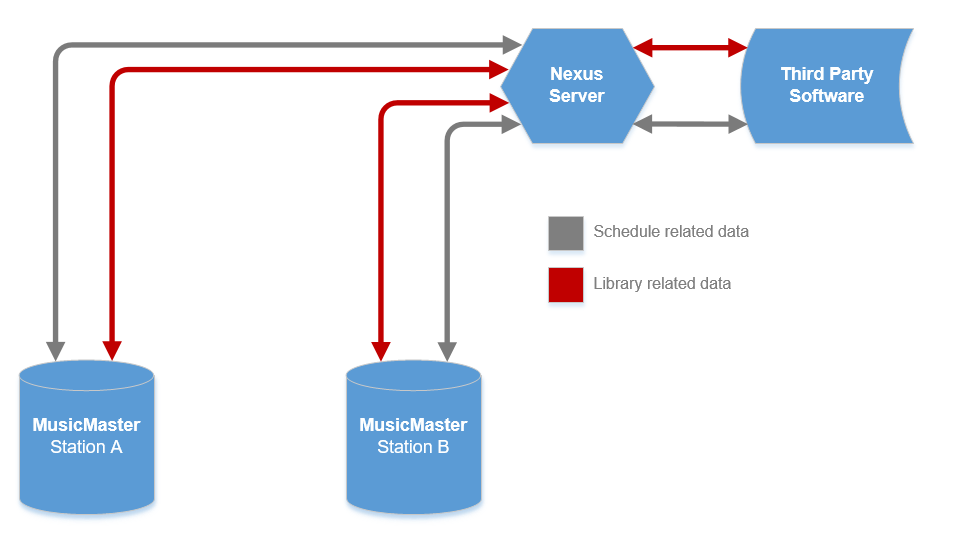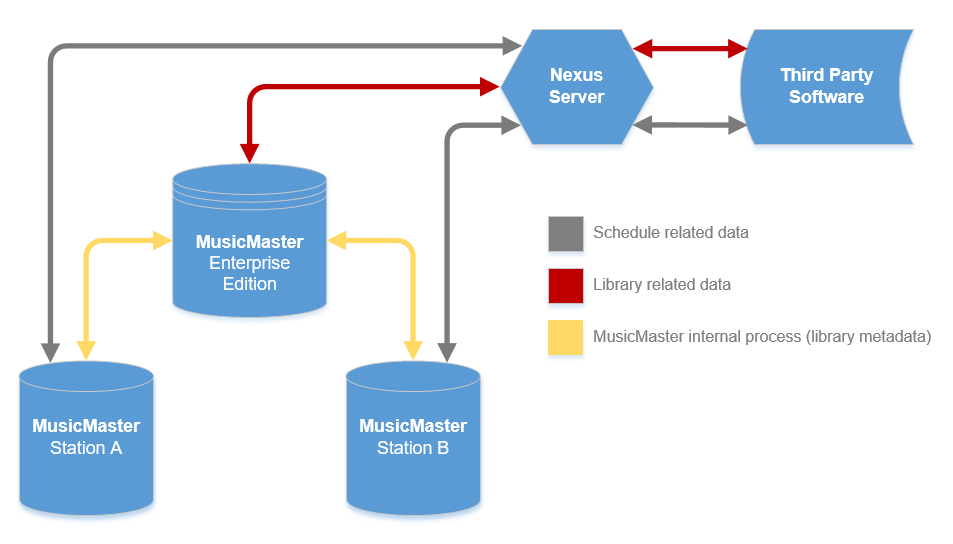Metadata configuration
MusicMaster databases store metadata in fields. Each field has a Field ID number that is unique, even if the name is not. Field ID numbers under 100 are system (internal) fields. These should be considered read-only except for Field ID 3 (Category) and 12 (RunTime). Fields starting with 101 are user-defined to meet the needs of the music programmers and format. The number and type of fields will likely vary from database to database. This should be kept in mind if you are setting up Nexus to work with more than one database as the configurations will likely need to be altered for each to work properly.
MusicMaster does have an internal ID field called SongID. It is Field ID 1. This number is unique to the element. Should you delete the element, the number will never be reused. Further, no two databases are likely to have the same SongID for the same element. While possible, it would be purely a coincidence. Referencing an element by the SongID field will be discreet in the specific database.
Enterprise
It is possible to share data between databases. This is considered an Enterprise database. The Enterprise "station" contains the meta data and then each individual "station" receives the data it needs to operate. Here's an analogy that might help to understand how this works:
Your local library contains lots of books on many different subjects. It has a catalog that you can use to search to find all the books on a subject, let's say "cars" or "toys". You could then go to the stacks and pull all those books on cars or toys or both. In MusicMaster, Enterprise functions as that library. It contains all the music you might play. You have multiple stations that play different, but perhaps similar formats. Let's say "rock" and "classic rock". Using Enterprise, you can enter the song information once and specify that the song can be used in multiple stations. This allows you to minimize data entry while at the same time allowing you to pick and choose which songs will be available in specific stations.
The efficiencies occur when you need to update the information on the song or have it play on multiple stations. Make the change once in Enterprise and that information is transferred down to all the stations that use that song. When the song crosses over formats, just check it off and the other format/station will have the song too.
You determine which fields are maintained at the Enterprise level (think fields that don't change like Artist, Title, Album) and which are maintained at the station level (Tempo, Research Scores).
This field division gives you the added benefit of giving the song a specific code on one station and a completely different code on another. Tempo is a great example of that. You can probably think of a song that would be considered up tempo in one format but slow in another.
The local station contains all this specific information along with the rules and scheduled logs.
Whether you have a single station or an Enterprise setup, information will move between your MusicMaster data, Nexus and the third-party system. Here are a couple of illustrations representing the different models.
This model shows a Nexus installation connected to a third-party system and two individual MusicMaster stations.
This model shows a Nexus installation connected to a third party system and an Enterprise MusicMaster database. That Enterprise database then is connected to two MusicMaster stations.
Types of Data
MusicMaster has two main types of data: library and schedule.
Library
These are the fields that contain the information on the music or non-music elements in the library. This would include fields like Artist, Title and Album to name a few. MusicMaster has different field types allowing you to hold the information in appropriate types. For instance, you can use a text field for Artist and a numeric field for a research score.
Field types available include: Attribute (Combo, In/Out, Multiple, Overall), Date, Keyword (Multiple, Single), Length, Memo, Numeric (Currency, Fixed, Float), Text, Time and Yes/No.
Each field type has different rules and capabilities. We are happy to discuss the different types with you and make sure your data is set up to meet you needs.
Schedule
Schedule data is information about how the element scheduled. This includes information about the date/time the element aired. There are specific fields types that can be used and specific fields that can be called for to recall this information.
Field Types
| TYPE | DESCRIPTION |
|---|---|
| Library elements | These are any music or non-music element with a SongID |
| Lognotes | These are typically text elements that display information in MusicMaster or a third-party system. These elements can also be used to pass commands to the third-party system. |
| Time marker | This element can be used to control the timing of an hour or segment |
| Traffic | This element represents where the commercials occur in the log. This element can either function as a placeholder or can also be configured to show the specific traffic spots. If the spots are imported, they are only for external reference and are not part of the MusicMaster library. The spots would only exist in the scheduled day. |
Fields
| FIELD | PROPERTIES |
|---|---|
| AirDate | Date of broadcast |
| AirTime | Time of broadcast. It should be noted that AirTime can be different from broadcast time due to other facts like talk time, commercials or other elements or timing considerations on the playout system. |
| HistoryID | This is a unique identifier for the element within a 24-hour period. If the element airs more than once during that time, each instance will have a unique identifier. The 24-hour period depends upon the Broadcast Day |
| Schedule: RunTime | When connected to a system that does automatic reconciliation, this is the actual played length of the song expressed in MM::SS with a maximum duration of 99:59 |
| Schedule: Transition | This field can be used to store specific information against the HistoryID rather than the element. It is considered a property of the specific scheduled element. |
| SongID | This is the unique, internal number for an element within MusicMaster. A SongID is never reused, even if the element is deleted from the library. |



